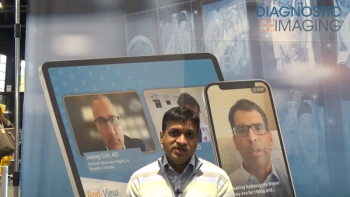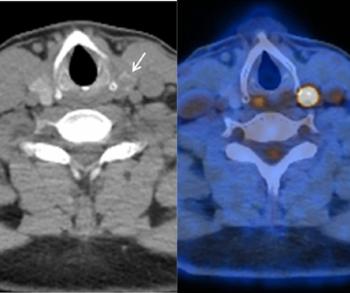
Toshiba 256-slice CT delivers 4D clinical images of liver cancer
Toshiba has been experimenting for years with a 256-slice CT, developed in collaboration with the Japanese government. Much of the work has been focused on engineering, but clinical studies have begun. Researchers from institutions in Chiba and Osaka, Japan, are producing dynamic images of liver cancer.
Toshiba has been experimenting for years with a 256-slice CT, developed in collaboration with the Japanese government. Much of the work has been focused on engineering, but clinical studies have begun. Researchers from institutions in Chiba and Osaka, Japan, are producing dynamic images of liver cancer.
The prototype employs a novel detector comprising 912 channels divided into 256 segments, as reported in Nuclear Science, IEEE Transactions in October 2003. Each element is approximately 1 mm square. The data sampling rate is 900 frames per second. The dynamic range of the analog-to-digital converter is 16 bits. The gantry rotates once per second.
Data are transferred from the gantry using laser diode and photodiode pairs, achieving a net transfer speed of 5 Gbps. Volumetric data of 512 x 512 x 256 voxels are reconstructed with a Feldkamp-Davis-Kress algorithm.
Engineers from Toshiba and the Japanese National Institute of Radiological Sciences had been concerned that artifacts might occur because conebeam scans following a circular orbit do not collect enough data to make an exact volumetric reconstruction. Early tests of the prototype and comparison of results to those of a 16-slice scanner allayed some of those fears, determining that image noise, uniformity, and high contrast detectability were independent of z coordinates.
Some distortion was found and related to a Feldkamp artifact. The 16-slice system was found to detect objects better at the midplane, due at least in part to circular bandlike artifacts. Performance of the prototype was tested on phantoms as well as several human volunteers.
Since reporting these findings in the June 2004 issue of Medical Physics, the Japanese team has moved on to clinical studies of three randomly selected patients with hepatocellular carcinomas. The resulting 4D liver studies detected lesions using dynamic contrast enhancement in an almost simultaneous volumetric imaging cine mode.
Dynamic 256-slice CT obtained continuous 3D coronal renderings 30 seconds after contrast injection. The hepatic veins, abdominal aorta, and renal arteries were best visualized at 30, 34, and 36 seconds after injection, respectively. The technique also allowed observation of the backflow of contrast material to the inferior vena cava in one patient experiencing heart failure.
The images, 256 slices of 0.5-mm width, were obtained with one-second rotations over 10 seconds. The scanner captured structures with a craniocaudal distance of approximately 10 cm in any plane, according to the results reported by Dr. Shinichiro Mori and colleagues in the July issue of the American Journal of Roentgenology. Several postprocessing techniques, including full-volume renderings and maximum intensity projections, were applied.
The system could cover one or more organs during one phase of contrast enhancement, the researchers concluded. It could also produce functional studies of the head, liver, and renal and coronary arteries.
Newsletter
Stay at the forefront of radiology with the Diagnostic Imaging newsletter, delivering the latest news, clinical insights, and imaging advancements for today’s radiologists.



























